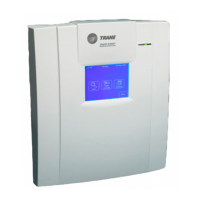Fiber-Optic UCM Communication
BMTW-SVN01F-EN 65
degradation (decibel loss). The signal degradation must be less than
14 dB on each fiber.
Fiber-Optic Modems
The EIA-485 data transceiver (D1300) has one fiber-optic port and one
twisted-pair (EIA-485) port. The EIA-485 data repeater (D2300) has two
fiber-optic ports and one twisted-pair (EIA-485) port. Each fiber-optic
port has two connections, one for transmitting information and one for
receiving information.
An illustration of a D2300 fiber-optic modem and the connections to it is
provided in Figure 31. The EIA-485 data transceiver (D1300) looks like
the EIA-485 data repeater (D2300) shown in this figure, but it has only
one fiber-optic port. The mounting and power wiring is the same for both
types of fiber-optic modems.
Figure 31. EIA-485 Data Repeater (D2300) Fiber-Optic Modem
Mounting and Wiring Fiber-Optic Modems
1. Mount the fiber-optic modem on the wall using the four mounting
screw holes on the modem.
2. Connect power to the modem using the ac adapter provided with the
modem. The adapter has two wires; one black with a white stripe, and
one solid black. The white striped wire connects to the 12 Vac/Vdc
connection on the modem, and the solid black wire connects to the
ground (GRD-2) terminal.
Note:
Use fiber-optic cable for long distances, interbuilding cabling,
and/or other high electrical noise areas such as petrochemical
installations, electronic rooms, and near hospital NMR or X-ray
rooms.

